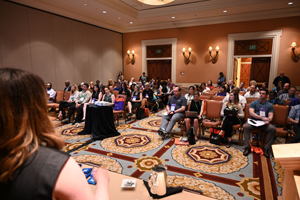
In a Sunday session at the Technology & Transfer Conference, Samantha Smith of the South Dakota School of Mines & Technology (SDSMT) shared her perspective on “Creating a Transfer-Friendly Institution.”
In 2017, various offices at SDSMT, including student affairs, faculty, advising, admissions and the registrar, came together to review new student onboarding and make some major improvements. The group was formed as a result of the Higher Learning Commission
Strategy Forum and has continued to work together on transfer-related projects ever since.
“We looked at orientation, transfer credit policies, student success data, and first-semester issues for students,” Smith said. “A lot of different offices were involved -- it was a campus-wide effort -- and we couldn’t have done
it without buy-in from the whole campus community.”
Some steps they took included:
Addressing gaps in institutional knowledge. One of the biggest successes to come out of those discussions were changes to transfer policies -- and raising campus awareness of the existence of those policies.
“For example, no one knew we had transfer credit appeals policy until we formed this group, even though it was established in 2009,” Smith said. “There were a lot of gaps in institutional knowledge we were able to resolve and get better
training for.”
Making necessary tech upgrades. Another major success was the implementation of TES and Transferology, replacing a homegrown database that wasn’t sufficiently serving institutional needs.
“TES has been a gamechanger with how we’re able to store transfer credit,” Smith said.
SDSMT also implemented better tracking and orientation of transfer students.
“Freshmen are tracked pretty heavily -- from application to acceptance and commitment, but we’ve never reported transfer until last year,” Smith said.
Revamping orientation and communication. Previously, freshmen and transfer orientations were separate and unequal. In the past, transfer orientation wasn’t required and was only an hour long with no opportunity to meet current students.
Working closely with the student senate and hosting open forums, they solicited feedback from transfer students about how to improve orientation and topics they’d like to see. With that feedback, transfer orientation has been revamped to include
mingling, student panels with leaders, welcome week events, and peer mentorship.
Communication has also been enhanced to offer clearer guidance about credit evaluations and other resources.
“Now we have an interactive checklist as students are accepted to help them through the process: set up a student account, complete a housing application, etc.,” Smith said. “It’s all in one place.”